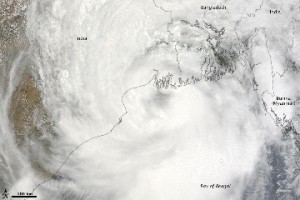Droughts and Floods
Map showing the site where river Bagmati breached its embankments in Sitamarhi, Bihar in 2009
Posted on 04 Aug, 2009 09:50 AMThe following map from South Asia Network on Dams Rivers & People gives a schematic sketch of the Bagmati Breach site near Tajpur in Bihar’s Sitamarhi district.
Rapid assessment of the flood situation at Tilak Tajpur Panchayat in Sitamarhi, Bihar
Posted on 04 Aug, 2009 09:30 AMQueries, request for information & additional clarifications can be sought via the comments section.
Download here: Rapid assessment report - Tilak Tajpur Panchayat
Pictures from the Bagmati embankment breach in Bihar in 2009
Posted on 03 Aug, 2009 10:10 AMThe google map at this URL shows Runi Sayedpur and Sitamarhi, along national highway 77: http://tinyurl.com/lxwfmj
Background documents on the Bagmati embankment breach: Article and presentation
Posted on 03 Aug, 2009 09:46 AM1) A presentation from the Central Water Commission of the Government of India studying the flood problem on the Bagmati and making some recommendations:
flood-management-in-bagmati-basin
Bagmati river embankment breaches causing floods and widespread destruction
Posted on 03 Aug, 2009 09:09 AMPhotograph of flooding due to breach in Bagmati's embankment, taken by NGO: Ghoghardiha Prakhand Swarajya Vikas Sangh, Madhubani"
Press Release : Water Initiatives Orissa
Posted on 05 Jun, 2009 12:15 AMGuest Post by: Ranjan Panda
Sambalpur 27.5.2009
What 'Water Initiatives Orissa (WIO)' had found out three years ago have been substantiated now by a World Bank report, titled 'Climate Change Impacts in Drought and Flood Affected Areas: Case Studies in India'. The World Bank report , which took Orissa as a case study of flooding in a climate change scenarios - has referred to projections that 'temperatures, precipitation, and flooding are likely to increase, with adverse impacts on crop yields and farm incomes. Among the more substantial effects is a spatial shift in the pattern of rainfall towards the already flood-prone coastal areas'. Three years ago the WIO had found out significant increase in average annual rainfall in coastal districts like Baleswar and Puri. Now the World Bank report has projected 23 per cent increase in annual mean rainfall in that region.
Negotiated approaches to Integrated River Basin Management (IRBM) - A Conference Report by Gomukh Trust
Posted on 04 Jun, 2009 03:35 PMThese documents deal with proceedings of the discussion initiated by Gomukh Trust, Pune with support from Arghyam, Bangalore on “Maharashtra Water Resources Regulatory Authority Act” to examine it in the context of Integrated River Basin Management and community participation. The objectives of the conference were –
Real-time flood warning map from NASA
Posted on 01 Jun, 2009 05:29 PMFlood warning: NASA (National Aeronautics and Space Administration, USA) has a realtime map that gives potential flood areas after 24 hours of rain. (The details of the criteria of flooding are not clear)
Information on droughts and floods in India by ministry of water resources
Posted on 01 Jun, 2009 04:24 PMFloods: In India, out of the total geographical area of 329 m ha., the flood prone area has been estimated as 45.64 m.ha. Heavy flood damages were experienced in the country during the monsoon of 1955, 1971, 1973, 1977, 1978, 1980, 1984, 1988, 1989, 1998, 2001 & 2004.
Cyclone Aila 2009
Posted on 01 Jun, 2009 11:27 AMTropical Storm Aila struck southern Bangladesh and eastern India on May 27, 2009. The New York Times reported that floods and mudslides killed at least 191 people and left hundreds of thousands more homeless. As of May 27, the death toll was expected to rise. Images from The Nasa Earth Observatory.
The Moderate Resolution Imaging Spectroradiometer (MODIS) on NASA's Terra satellite captured this true-color image of Aila on May 25, 2009, the same day that the storm temporarily strengthened to a Category 1 cyclone. Aila almost completely fills this scene, stretching from the Bay of Bengal deep into India, Bangladesh, and Burma (Myanmar). On May 25, Aila's wind speeds ranged from 74 kilometers per hour (46 miles per hour or 40 knots) to 120 kilometers per hour (75 miles per hour or 65 knots). More information and detailed images can be accessed here:Cyclone Aila





